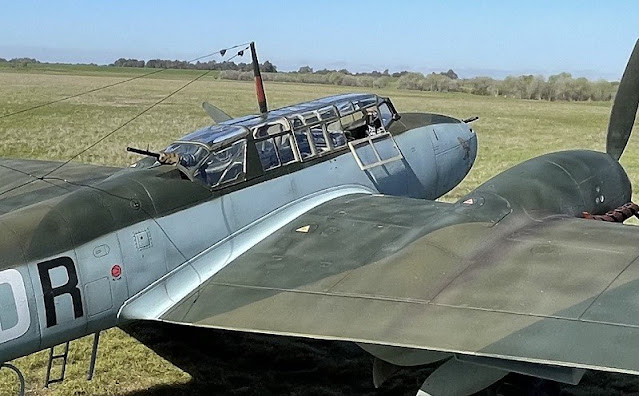" ..Shot-up Me 109 glides back across the Channel - outstanding performance from a German fighter pilot - gliding more than 70 km home..
"..Unteroffizier Hannes, der als Rottenhund eines Schwarms fliegt, wird gleich von zwei englischen Maschinen angegriffen... "

Uffz. Karl Hannes flew during 1939-42 in 5./JG 2 and successfully survived combat on the Westfront during this period. His Staffelbezeichnung was "12". He returned his first victories - downing Spitfires - during September 1940. He was credited with five victories over the RAF. His 5th claim was for a Hurricane, west of Le Touquet during the evening of 17 August 1941.
A PK report dated 23 September 1940 described an incident during a Ju 88 Begleitschutz escort sortie over London flown by the Geschwader Richthofen from their bases in northern France.
Kriegsberichter Gerhard Linke takes up the story .......
"..having over-flown the Channel at 6,000 metres, the formation came under attack from RAF fighters, diving from a favourable position directly out of the sun. Hannes quickly had two on his tail, one of which gave him a long burst of fire into the engine and fuselage from fifty metres. The enemy's shells hit the Me 109 hard, even slamming into the steel plate that protected the pilot's head. A glance at the instrument panel told Hannes he was rapidly losing his coolant and that the engine would likely seize at any moment. He chopped the throttle and his fighter fell away to the left. At that moment the RAF fighter swept past him and attempted to peel off to the right. With his engine still barely turning over, Hannes seized his chance. His 'sick' Me 109 fell in behind the RAF fighter - so long as the engine was running then he was still able to fire his MGs. He cut across the Spitfire's curve - even if he was going to go down he would teach the Englishman a lesson. Barely thirty metres in front of him the Spitfire was framed in his Reflexvisier gunsight. Hannes squeezed the two firing buttons on his control column, unleashing in the same moment the first rounds from his MGs and cannon. Not for an instant had the Englishman expected that the Me 109 would still pose a danger to him. He attempted a split-S away but Hannes was on his tail as both machines fell away through one thousand metres. Time and again his rounds hit the Spitfire's fuselage and then a cannon shell into the engine - the Spitfire was soon trailing a banner of black smoke. Hannes could see flames licking from the cockpit. Der Gegner ist erledigt - his adversary was done for! But now his propeller juddered to a stand, the three blades starkly black against the horizon. 4,800 metres altitude and still 30 kilometres from the Channel which was at least 40 kms wide at this point. Beneath his wings the meadows and fields of the English countryside. Hannes kept his cool, feathered his prop ('Segelstellung') - the positions where the blades gave the least resistance and held the stick gently in his right hand -'keine unbedachte Bewegung darf gemacht werden'...no careless movement could be performed, every metre was precious. It is a strange feeling for a fighter pilot to glide through the air with no engine noise... [..]
As a precaution Hannes jettisoned the canopy in case he had to leave the 109 quickly...[..] Zehn lange Minuten! Ten long minutes! Jetzt kommt der Kanal. At 3,000 metres he glided out over the Channel, the machine slowly losing height - das fliegerische Gefuhl ist jetzt alles....[..] With a slight whistling in the slipstream the Me 109 came in over the French coast at a height of fifty metres. To his right he spotted a freshly mown field and set up for a belly landing. He touched down softly, slid along for ten metres and came to a stand. Hannes sat motionless for a moment. Then rubbing the dust thrown up by the landing from his eyes and face, he slowly unbuckled his belt, pulled himself up out of the seat and climbed down from the cockpit. The aircraft had sustained only slight damage in the landing but Hannes counted over twenty bullet impacts, mostly in the wings and the fuselage. There were just two in the radiator and it was these that had brought him down..[..] .."
The display of airmanship shown by Hannes in downing a Spitfire in his crippled fighter and then gliding it home was second-to-none and won the fulsome praise of his comrades - 'Hannes hat ..[..] eine Leistung vollbracht, die gerade bei seinen Kameraden in der Jagdfliegerei bewundert wird..' His feat was evidence of the 'immense skill' and 'Siegeswillen' or 'will to win' of the men of the German Luftwaffe..
Below; Uffz. Karl Hannes in front of his (presumably) 'red' or 'black 12' of 5./JG 2 - a 'cropped' version of this photo was first published in the April 1977 issue of Jägerblatt.
Above; Karl Hannes was subsequently posted to Erla and served as a factory 'Einflieger' (test pilot) and in the works Jagdstaffel. In this role he would perform more than a few emergency landings..
Below; Hannes seated on the spinner of a crash-landed Gustav coded 'G1'
Below; Hannes flew this modified Messerschmitt Bf 109 G-4 coded "H1" (Hannes, aircraft # 1 ?). The aircraft was written off in a crash landing during 1943. Hannes can be seen near the engine bearer arm, hand resting on one of the cowl MGs..

A 'second' "H1" (?) trialed a system for direct injection of liquid oxygen into the engine turbocharger to significantly improve the rate of climb.

























